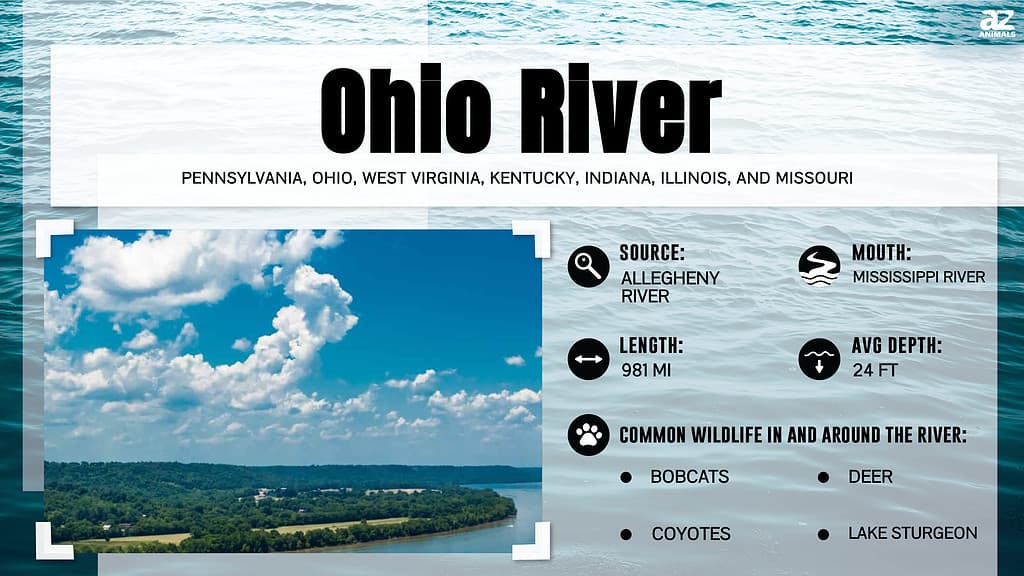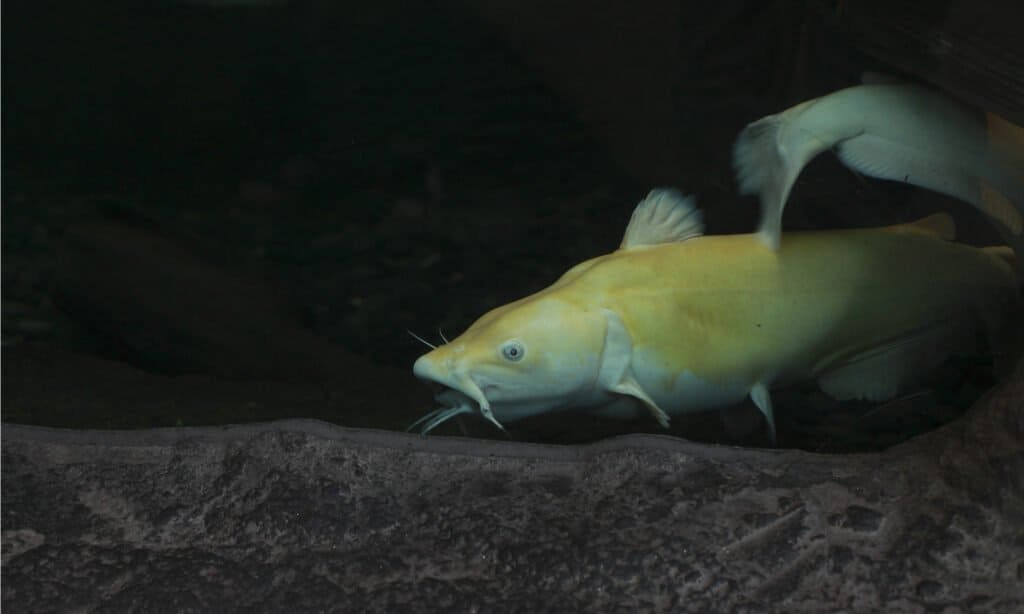
According to Thomas Jefferson, “The Ohio is the most beautiful river on earth. Its current gentle waters clear, and bosom smooth and unbroken by rocks and rapids, a single instance only excepted.” Today this river sustains millions of people and is a transportation route for commercial ships.
It has also been a focal source of growth for those who have built cities in its vicinity. But how wide is the Ohio River at its widest point if commercial ships can use it for transportation and people continue to rely on its flowing waters for sustenance? Let’s find out.

How wide is the Ohio River at its widest point? Approximately 1 mile.
©Nat Chittamai/Shutterstock.com
The Widest Point of the Ohio River
The Ohio River widens to roughly 1 mile at its broadest point. This area is at the Smithland Dam, near Smithland, Kentucky, just west of downtown Louisville, Kentucky.
Exploring the Ohio River
Besides its width, the Ohio River is also one of the longest in America, at 981 miles. It begins its journey at the confluence of the Allegheny and the Monongahela Rivers in Pittsburgh, Pennsylvania. Then, its extensive 981 miles stretches across six states and ends in Cairo, Illinois, before entering the Mississippi River. The Ohio River, which is the Mississippi River’s largest tributary, runs in or on the borders of six states, which are:
- Illinois
- Indiana
- Kentucky
- Ohio
- Pennsylvania
- West Virginia
The Ohio River Basin
Other than these characteristics, the Ohio River’s drainage basin covers 14 states. Notably, its largest tributary is the Tennessee River which is instrumental in the size of the Ohio River’s drainage basin covering 205,000 square miles.
This drainage basin equals approximately 5% of the total extent of the U.S. mainland. Unsurprisingly, it stretches across many of the southeastern states in the country, including:
- Illinois
- Indiana
- Ohio
- New York
- Pennsylvania
- Maryland
- West Virginia
- Kentucky
- Tennessee
- Virginia
- North Carolina
- Georgia
- Alabama
- Mississippi
The Ohio River’s basin has given life to the United States as it is currently one of the country’s most populated and industrialized river basins. Significantly, its basin is home to over 30 million people and is a drinking water source for over 5 million.
The Depth of the Ohio River
When discussing the major points of rivers, it is necessary to examine their depths. The Ohio River is naturally shallow but has deep areas, many of which are due to human intervention. When people built dams along this river, they also deepened certain sections.
Now, the average depth of the Ohio River is roughly 24 feet, with a maximum depth of 168 feet. The deepest point is west of Louisville, Kentucky, with an average depth of 132 feet for 50 miles. Large shipping vessels can readily travel through this region, making it a transportation hotspot.
Where is the Ohio River Located on a Map?
The Ohio River is located in the eastern United States, running through six states: Illinois, Indiana, Kentucky, Ohio, Pennsylvania, and West Virginia. It stretches for approximately 981 miles from its source at the confluence of the Allegheny and Monongahela Rivers in Pittsburgh to its mouth at the Mississippi River near Cairo, Illinois.
Getting to the Ohio River by car or public transportation will depend on which part of it you plan to visit. Major cities such as Cincinnati and Louisville are situated along its banks, with several interstate highways leading directly to them. Smaller towns can be accessed via state routes that run parallel to or intersect with major highways.
On a map of North America or even just the United States, finding the Ohio River is quite easy. It runs almost diagonally from the northwest (Pittsburgh) down toward the southeast (Cairo). Its shape has been described as an upside-down question mark due to a sharp bend around Wheeling Island in West Virginia before continuing southward towards Kentucky and beyond.
Development Along the Ohio River
Many large cities have risen along the banks of the Ohio River. Examples of these are Pittsburgh, Pennsylvania, Cincinnati, Ohio, Louisville, Kentucky, Evansville, Indiana, Huntington, and West Virginia. Look closer, and you will see 38 power generating facilities along its banks and main ports at Cincinnati, Louisville, and Pittsburgh.
Due to its considerable length, the Ohio River has been a transportation route of choice since people began living along its edges. And though its flow is predictable, it has one major obstacle interrupting this flow – the Ohio Falls at Louisville. To navigate these falls, officials organized the building of locks to control the descent of vessels over 2.5 miles.
Construction companies built 13 dams as part of their plans, spread across the river, with locks assisting the smooth passage of boats and commercial ships. Commercial ships on the Ohio River convey over 180 million tons of cargo and often carry loads like coal, oil, steel, gravel, petroleum products, and manufactured goods.
Because of heavy-duty use, this river has been victim to pollution, mainly from urban runoff, agricultural activities, and abandoned mines. To combat this, officials established the Ohio River Valley Sanitation Compact in 1948 to improve the water quality. Today, the river is home to marinas and recreational spaces and provides drinking water to millions living in proximity to its voluminous waters.
Fish in the Ohio River
The long, wide Ohio River is the home of many fish species that attract enthusiastic anglers. You will find various types of Bass like Largemouth, Smallmouth, Rock, Black, White, and the Striped species. Also, you find Largemouth Bass in the river’s creeks during the spring as the water temperatures rise above 50 degrees Fahrenheit.
Once the waters warm during the summer, Largemouth move to deeper waters. If you prefer Smallmouth Bass as an angler, you’re lucky because they live throughout the length of the Ohio River regardless of the water temperature.
Other fish living in these waters are the Saugar and Walleye. You are more likely to find these species in tailwater areas during the spring, fall, and winter months. During the summer, they tend to frequent the streams.
The Ohio River is also home to catfish found throughout its waters. Different Catfish in the Ohio River include the Blue Catfish, Channel Catfish, and Flathead Catfish, to name a few. However, Blue Catfish are often a rare sign in the Pennsylvania, Ohio, and West Virginia waters. Other fish that are common are the Bluegill, Trout, and Crappie.

Blue Catfish live in the widest part of the Ohio River and its shallow areas.
©Brandy McKnight/Shutterstock.com
The Ohio River is also home to mussels that are important in all rivers. Mussels filter the water and reduce silt, sediment, and pollutants. Besides this, they are food for other marine life. Remarkably, there are over 45 different species of native freshwater mussels in the Ohio River, of which eight are federally endangered, such as:
- Fanshell
- Pink Mucket
- Sheepnose
- Spectacle case
- Snuffbox
- Purple Cat’s Paw Pearlymussel
- Clubshell
- Rayed Bean
Up Next
Interested in more river-related articles? Click on the links below:
- How Deep is the Amazon River? It is quite simply one of the most magnificent rivers on our planet. It’s actually the longest too. But how deep is it? The answer and other intriguing facts about this mighty waterway await you here.
- How Deep is the Columbia River? It is the greatest source of hydroelectric power and is the largest river in terms of volume in the United States. How deep is it? Find out the answer as well as other exciting facts about this river which also has one of the largest drainage basins in the States.
- The Deepest River in the United States: The United States is known for its beautiful waterways. But which of them is the most impressive in terms of its depth? And what more is there to it? Discover the answers here.
The photo featured at the top of this post is © ESB Professional/Shutterstock.com
Thank you for reading! Have some feedback for us? Contact the AZ Animals editorial team.







